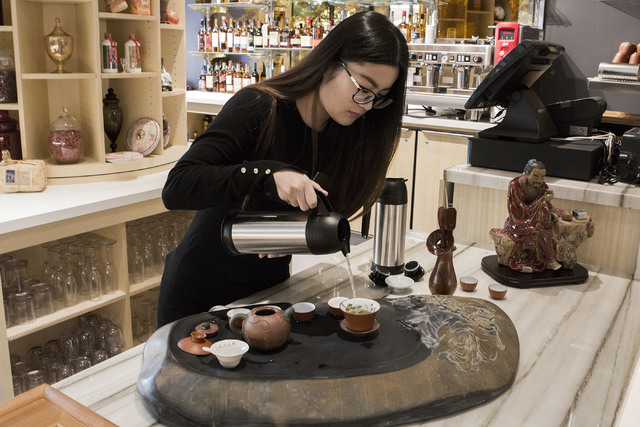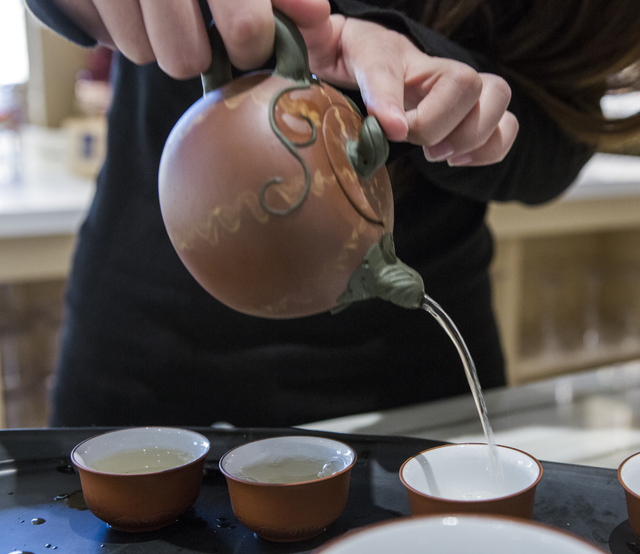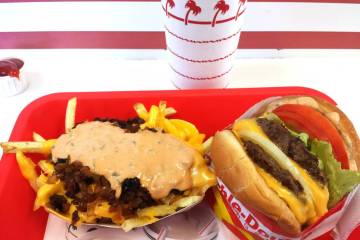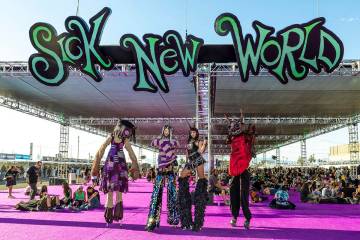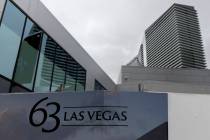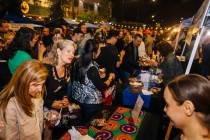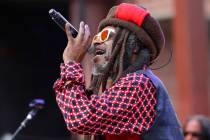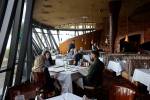Lucky Dragon’s tea sommeliers educate guests about flavors, service
On a stone slab at the bar, Lola Zhao heats six petite terra cotta cups by pouring hot water into them. She then rinses the delicate green tea leaves before steeping them in a teapot shaped like a pumpkin. After brewing for a mere 15 seconds in 180-degree water, Zhao pours the pale green tea into the six cups, each just large enough to hold a couple of sips.
Zhao can repeat the process with the same leaves, from a tea variety called Qinba Wuhao, as many as six times, with each infusion drawing out new flavors, colors and mouthfeel.
The presentation — known as a Gongfu tea service — will be a familiar sight for visitors at the new Lucky Dragon casino’s lobby and Cha Garden, a 24/7 tea room. The process is more functional than ceremonial. Presented with few flourishes, the steps ensure guests will enjoy the tea’s optimal flavor.
Gongfu service will be continuous at Lucky Dragon, offering tiny cups of tea to incoming guests. Visitors can also take a seat at Cha Garden, choose a tea from the list of 50 and order it either in a pot or Gongfu style. The entire Gongfu service takes as long as 45 minutes.
The Lucky Dragon’s tea program, developed by beverage director Joe Muscaglione and Zhao, the tea sommelier-in-training, is part of the new property’s immersive experience, one that begins with a greeting from the doormen in Mandarin. The master tea list includes green, white, black, yellow, oolong and pu-erh varieties, all from mainland China or Taiwan.
Some, such as the Qinba Wuhao green tea that Zhao prepared, aren’t served anywhere else in the U.S., hotel officials say. At Lucky Dragon’s Cha Garden, prices range from $10 to $58 for a pot, depending on the type of tea. A pot serves about two people. Guests at Phoenix, Lucky Dragon’s fine dining restaurant, can also choose from the master tea list. Elsewhere, a list of eight teas is available, and three complimentary teas will circulate the casino floor.
“Las Vegas will also lead the nation in this tea movement,” Muscaglione says of Lucky Dragon’s program.
Zhao and Muscaglione — both of whom could be considered tea sommeliers — source the teas and provide guests with education when they visit Cha Garden. The title “tea sommelier” doesn’t require any formal training or certification; it can essentially be applied to anyone with a high level of expertise, though a “tea sommelier” does differ from the traditional tea master, which in China refers to someone who processes the tea.
Zhao, a student in UNLV’s hospitality program and Muscaglione’s apprentice, hails from the northeast Chinese city of Shenyang. She grew up drinking tea, visiting her uncle’s tea shop and watching her father drink tea every morning, though he drank it “Grandpa-style,” a less precise brewing method in which the tea leaves are put in a glass of hot water, and once they sink to the bottom, it’s ready to drink.
“Since I was little I was hanging around the tea shop and getting to know the teas,” Zhao says.
Though Muscaglione began his career working with wine (his resume includes positions at Joe Bastianich and Mario Batali’s Babbo in New York City and at Tao Asian Bistro), he’s been working with tea full time for the past several years. Most recently, he developed the tea menu at Chinese restaurant Niu-Gu on Jones Boulevard.
Though organic certification is more complicated in China, Muscaglione does try to source from small, family-owned farms that don’t use pesticides or herbicides. The relationships with these individual growers have been developed over many years and are maintained via WeChat, a Chinese social media platform. From the high, foggy tea fields, Muscaglione will get a message describing the latest crop. If he’s interested, those tea leaves can then be shipped to him within days.
“Some of them only make 12 kilos a year, and we get half of them,” Muscaglione says. The grower’s family name, growing elevation and the harvest date are listed beside each tea on the menu.
As Lucky Dragon’s tea sommeliers, Muscaglione and Zhao educate patrons about the wide variety of teas and their sources, and suggest teas that may fit their taste or introduce something new. The idea that certain varieties pair well with certain foods is an American one; in China, people primarily drink tea from their region. Nonetheless, Muscaglione says, teas can enhance certain foods.
“There’s actually some pairings that are wonderful together, which is why I’m an advocate for promoting it in this country even though it’s nonexistent in China,” Muscaglione says. “For example, something that’s maybe a fattier dish, you want something that’s maybe a little bitter to cut into some of that fat.”
Above all at Lucky Dragon’s Cha Garden, there’s something for both novice tea drinkers and connoisseurs. Anyone from either China or the U.S. can find something new and unfamiliar to try.
“Two people could come here — it’s a perfect first date — they can come here for as low as $12, sit for 45 minutes, maybe an hour, learn about tea, drink something that’s actually healthy for you, delicious,” Muscaglione says. “And it’s $12.”
Contact her at scorsa@reviewjournal.com and follow @sarahcorsa on Twitter.
RELATED
Lucky Dragon, Las Vegas' newest resort, firing up casino market
Las Vegas' newest resort, Lucky Dragon, is opening doors early
Lucky Dragon seeks to carve out niche in Las Vegas market
Lucky Dragon, being built near Las Vegas Strip, announces restaurant offerings



